The dominant flavor in this sausage is garlic, hence the name, garlic sausage. This is another great official Polish government recipe published in 1959, similar to Krakow sausage I posted about earlier.
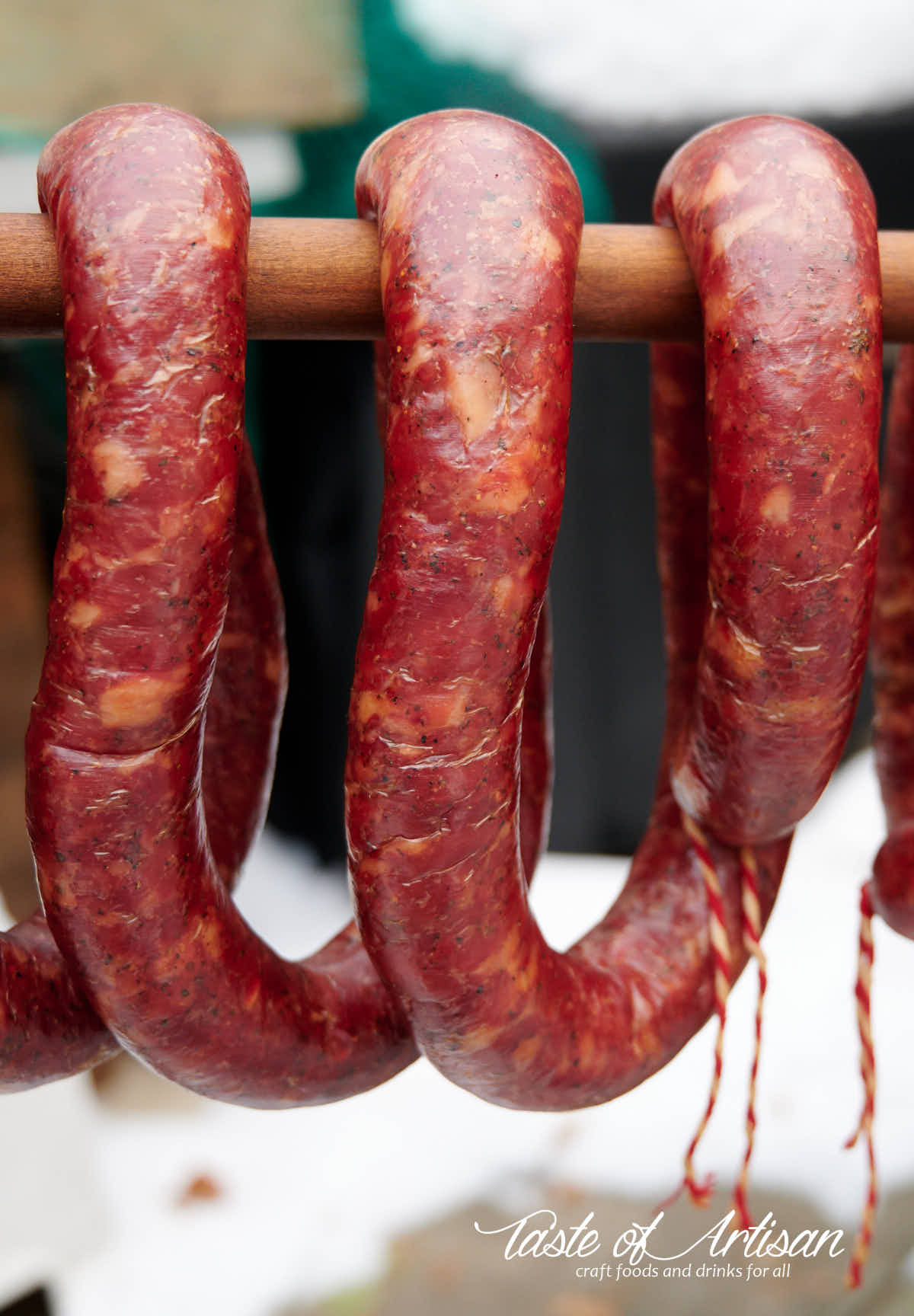
This sausage has a very good ratio of lean meat and fat, and the grind favors chunky texture, which I like a lot. The seasonings are subtle, even the garlic is not as noticeable as you would assume, given that this is garlic sausage after all.
Overall, this sausage comes very close to my all time favorite (swojska) Polish kielbasa, making it a close second.
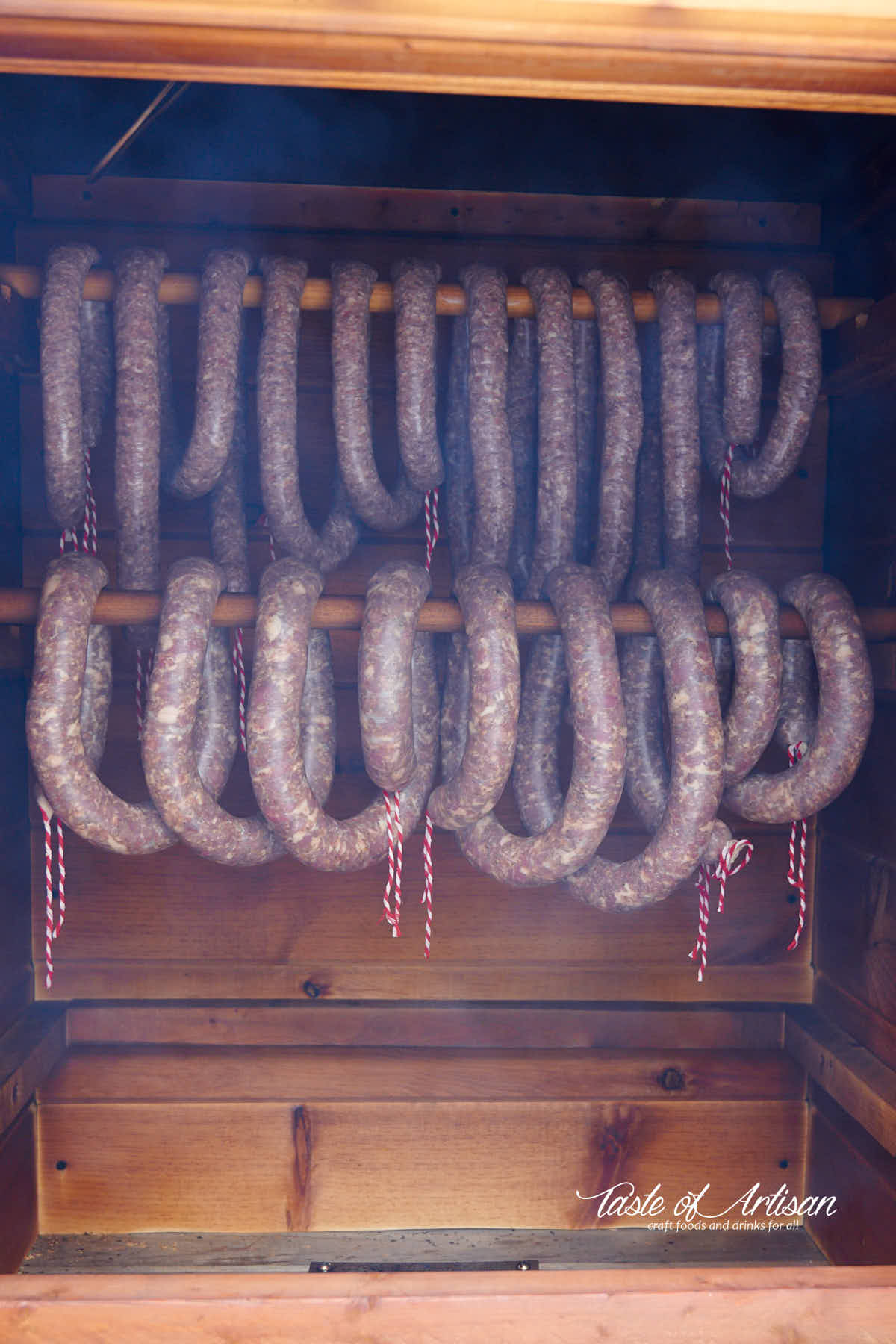
I used pork butt, beef chuck and pork back fat to make the sausage. You don't need to use these specific cuts but I find that pork shoulder works really well in this recipe. After butchering a boneless shoulder I picked up at Costco, I ended up with about 42% class II (up to 30% fat) and 58% class I (up to 10% fat) pork, about the ratios required in this recipe. The official recipe allows for some variance, so you can use a little less class I and a little more class II pork and vice versa.
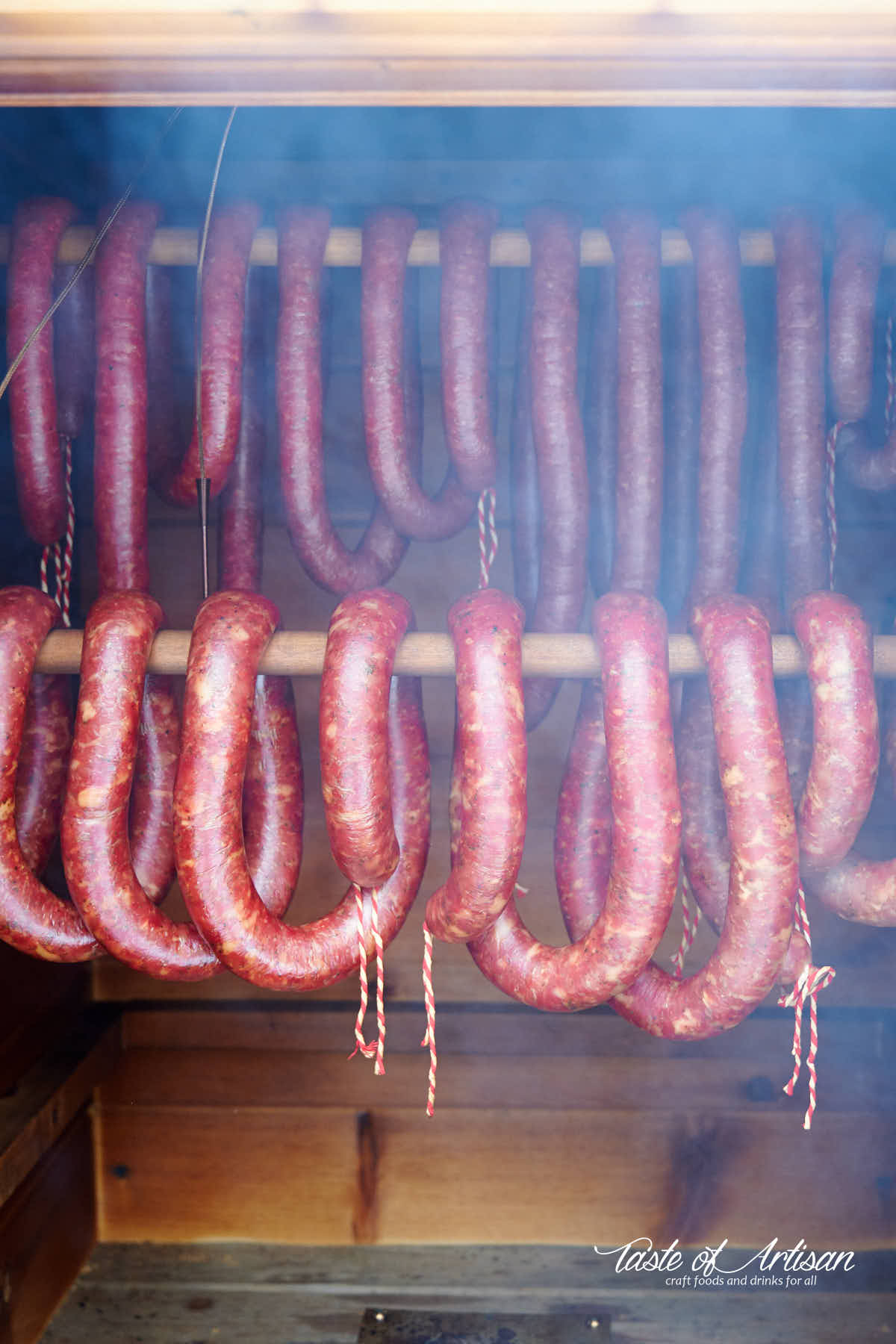
The smoking wood I used in this recipe is hickory and cherry. This combination provides a nice color, and a sweet, smoky flavor. I made a double batch, and decided to dry half of the sausage for a week in an unheated room, which is right now about 50F - 60F, 75% RH. The smell there is so good that I can hardly resist not breaking a piece of sausage off and devouring it.
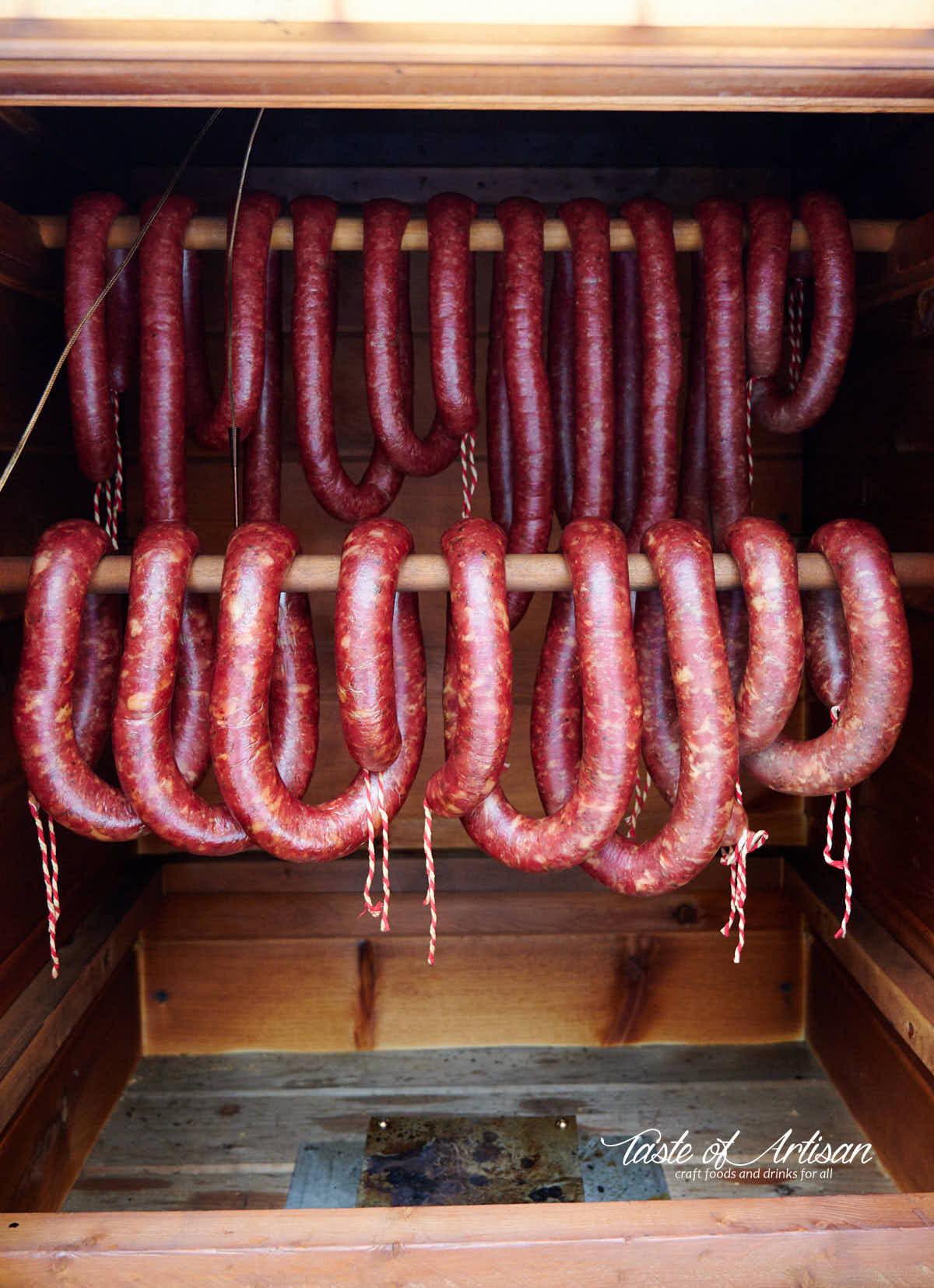
I finished cooking the sausage by poaching, as per the official recipe. Regardless, poaching is now my preferred finishing method as it's easy, predictable and quick. Sure, some color is lost but the skin doesn't harden, and that's a big plus too.
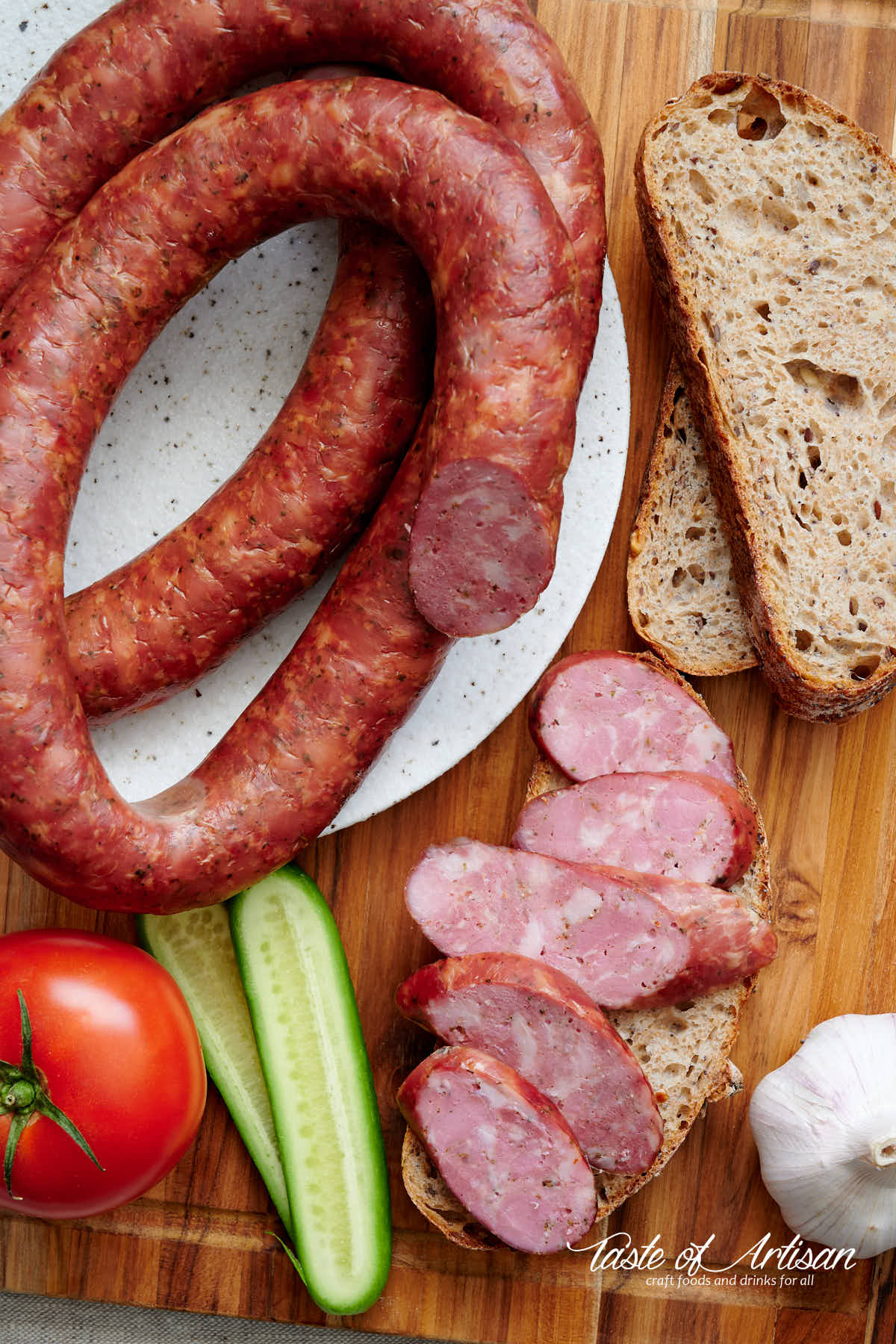
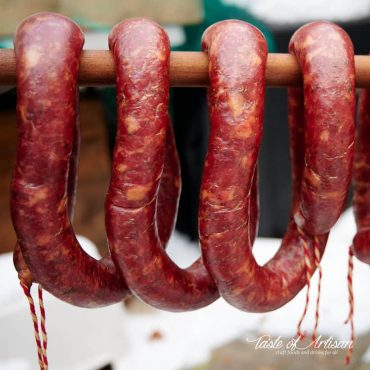
Garlic Sausage
Ingredients
- 350 g lean pork no more than 10% fat
- 200 g pork no more than 30% fat
- 250 g beef no more than 10%-30% fat
- 200 g back fat you can also use pork belly
- 9 g kosher salt
- 2.5 g Cure #1
- 3 g black pepper coarsely ground
- 10 g garlic 3 garlic cloves, pressed
- 1 g coriander
- 2 g paprika
- 2 g marjoram
Instructions
- Cut the meat, and the back fat, into 2" (5-6 cm) pieces, mix with the salt and Cure #1. Place in a container, cover and refrigerate for 48 hours.
- Grind the lean pork (class I) through a stuffing plate, pork class II and back fat through a 3/8" (10 mm), and beef through a 1/8" (3 mm) grinder plate. Ground beef can be emulsified, but it's not necessary. If emulsifying, add the seasonings at this stage.
- Mix the ground meats, with the seasonings, adding a cup of ice water.
- Stuff into beef rounds 1 1/2" (40 mm) or more, and tie with a butcher's twine. Prick any visible air pockets with a needle.
- Dry for about 60 minutes in the smoker at about 110F - 130F without smoke.
- Smoke at around 130F - 140F for 2 hours, until the casings develop brown color with a red tint. You may have to re-arrange smoke sticks during smoking to achieve even color.
- Poach at 161F - 165F for 25 - 35 minutes or until the internal temperature reaches 154F -158F.
- Shower with cold water for about 5 min, then let cool down and dry.
- Store in a refrigerator.
Nutrition


Fay Werbicki says
This is a very tasty recipe and I really enjoyed making it. I read most of the comments before attempting it and discovered that it wasn't common knowledge that sausages poached in plain water lose "flavour"... actually the salt from the sausage leeches into the water by osmosis. The flavour is augmented by the salt content so please remember to salt your water during the poaching process.
Victor @ Taste of Artisan says
Thank you for your comment. That's an interesting one. I've poached many batches of sausage and I have never noticed any reduction in saltiness. I suppose, theoretically, some salt may leach out, but in practice, I've never noticed that and never felt like salting water was needed. I am quite certain that the casing serves as a good barrier.
That said, I did some research on this and found no evidence of what you are saying. Can you point to the source?
Feiner in his Meat Products Handbook describes several production methods, e.g. German Frankfurters that are steamed or poached in a hot water bath to bring to doneness. There is no mention about salting the water. As well, Marianski in his Polish Sausages, Authentic Recipes And Instructions also describes poaching as a method for finishing smoked sausages, where unsalted hot water is used. At least, there is no mention of salting the water anywhere in his book.
alex says
great recipe but just one question. have you tried adding a binder -milk proteins to this recipe? i will be using a wildgame/pork meat mix
Victor @ Taste of Artisan says
Alex, I don't normally add binders. When you have the right meat to fat ration and mix well, binders are not needed. Some add binders to hold water, but that I like my sausages on the drier side, which is why I dry them for a week or two after smoking.
Bill Miller says
This was a really good recipe.
I used pork casings, about 32 mm. I also subbed parsley for the marjoram as I had that and not the other. I subbed in liquid smoke as sadly it’s really not practicable to set up a smoker at our townhouse in the village. Also put in 1/4 cup of skim milk powder from sheer habit.
Great bind on this, and I kept a medium grind as I prefer that texture, almost salami like.
Next time I might up the garlic and try drying some for a few weeks.🙂
Victor @ Taste of Artisan says
Glad to hear it, Bill. Enjoy!
John Hoffman says
I have made and love the Swojska Kielbasa Recipe! I’d like to attempt the Garlic Sausage recipe but I’m a little hesitant due to the fat content requirements of each meat in the recipe. Isn’t there an easier way?
Thank you.
OBH.
Victor @ Taste of Artisan says
Johh, lean pork is lean pork, should be pretty self explanatory. The second one - pork, use lightly trimmed pork butt. Untrimmed pork butt is 30% fat, lightly trimmed will be 20-25%. The third one - beef, use lightly trimmed chuck. Hope this helps. Good luck.
Spurwing Plover says
My late Grandpa made Garlic Sausage all by hand and when you fried it in a pan it would poke out each end
Victor @ Taste of Artisan says
So many different ways to make garlic sausage. Pan-fried garlic sausage is delicous.
Luís Osmar says
Por favor, me tire uma dúvida.
A carne suína magra (classe I) deverá ser moída em qual disco, qual espessura?
Victor @ Taste of Artisan says
Luis, lean pork (class 1) is ground through a stuffing plate, which has three holes about 1cm by 2cm. If you don't have it, just cut into 1-2cm cubes with a knife. Good luck!
Billie Harnden says
My garlic sausage turned out perfect, just how I wanted. Thanks a lot for detailed recipe, it helped a lot.
Victor @ Taste of Artisan says
You are welcome. ENjoy!
Night Heron says
My late Grandpa could measure everything by hand but one of the fun things about Garlic Suasge was when you fried it it would poke out each end if it wasnt sealed or pinched closed
John Balanik says
Victor,
I made your Swojska recipe and was so impressed with it I had to try the garlic sausage. I was kind of surprised about the minimal amount of garlic in this recipe given its name. I followed your recipe exactly except I doubled the garlic sorry we are garlic lovers here at my house (we grow our own) and again I was not disappointed it is awsome. This is only my second time making kielbasa but by following your recipes you are making me look like a rock star. My family loves the results and says I need to start my own restaurant lol. One question i have is my Masterbuilt smoker has a water dish built in it. But in all the recipes I've read no one ever mentions having water in the smoker. Once the sausage had been smoking for two hours at 140 I increased temp to 165 and added water to the dish. It didn't seem to help alot though. After 3 1/2 more hours I was only at 141 degrees internal temp. So I pulled and poached as you described although the hard part was keeping water at the desired temp. After like 20 minutes the sausage was at 155 quick and easy. I was not disappointed the flavor and color is amazing and the sausage has a great snap. Once again thank you so much for sharing and making us new guys look good.
Victor @ Taste of Artisan says
Hi John, you are very welcome, appreciate your detailed feedback. True, this sausage is fairly minimal on garlic but I wanted to keep the original Polish recipe for this sausage, well, original. I love garlic so I add more of it too. That's the beauty of making own sausages - you try a recipe, if you like it, you make it better by changing it to suit your own taste.
I find that adding hot steam during the 'baking' stage helps drive the internal sausage temps up quicker but a tray of water isn't very helpful. I am thinking of rigging my smokehouse with some sort of steamer for that but haven't had time to do that - lot's of other projects to focus on right now. My solutions to this problem are: poaching (works very well), baking in the oven - 30-50 minutes at 175F with convection (works very well), or make sausages in sheep's casings and finish in the smokehouse, which takes about 45 minutes in my smokehouse, this one works quite well too. You can't beat sausage/kielbasa made in sheep's casings, everyone here loves thin sausages and keep asking for them all the time.
FRANK WOLOSZYN says
GOOD MORNING VICTOR
I'VE BEEN MAKING SAUSAGE FOR SEVERAL YEARS NOW. A VERY OLD ITALIAN GENTLEMAN TAUGHT ME HOW YEARS AGO. I HAVE SMOKED BRISKETS, RIBS, WHOLE CHICKENS, ETC. SO...... WHAT CAUGHT MY EYE AS I WAS READING YOUR RECIPE FOR GARLIC SAUSAGE WAS YOUR STATEMENT THAT AFTER SMOKING THE SAUSAGE YOU
" finished cooking the sausage by poaching, as per the official recipe". WHAT DO YOU MEAN? I AM ONLY FAMILIAR WITH POACHING EGGS. CAN YOU PLEASE EXPLAIN ABOUT POACHING SMOKED SAUSAGE AND HOW TO DO IT?
THANK YOU
FRANK WOLOSZYN
Victor @ Taste of Artisan says
Frank,
After smoking kielbasa at low temp 130F-140F you need to ramp up the temperature in the smoker to bring the internal temperature of the sausage to the minimum of 154F or so, depending on the type of sausage. You can do it in the smoker, it takes a bit longer and I find that with low humidity it can take very long and I suspect in commercial smokers they also increase humidity which expedites the process. Another way is to take the sausage out of the smoker once it has reached the desired color and poach in hot water (about 167F - 175F) until the internal temp gets to 154F. Takes about 20-30 minutes depending on the thickness of the sausage. I've described this process in several of my kielbasa recipes, it works very well, is very predictable and takes a relatively short time.
Werner Schaarschmidt says
Hi Victor Cant wait for chicken recipe just to mention that a friend of mine is a german smallgoods butcher by trade and also helps me . We poach our sausages hams and bacon in a 2% brine solution that prevents loss of flavour that is 2Tbl spoons salt 2 litres water if this is a help to anyone thanks Werner
Victor @ Taste of Artisan says
Hi Werner, I didn't do any objective measurements/comparisons but my perception has been that there is no flavor loss when poaching encased sausage in plain water. But it would be interesting to compare the two side by side, which I will do the next time I smoke sausage. I am curious. I may very well start salting my water. Solid muscles without casings - those I poach in salted and seasoned water, you can even call it a 'broth', unless I vacuum seal them. Thanks for the tips.
Werner says
Hi I have been making sausages for 2 years i have a restaurant i have tried your polish sausage my customers think they are amazing as so do i we live in a farming community in rural Australia i have subscribed and i am hooked on your recipes thakns so much Werner
Victor @ Taste of Artisan says
Hi Werner, sorry for the late response. Your comment put a smile on my face and made me very happy - it's comments like yours that motivate me to continue posting more content on my blog. More recipes are coming, I am especially excited about posting my smoked chicken sausage recipe that I've made maybe 6 times in the last few months, my family keeps asking for more... It started as a quick experiment but turned out to be one of my most successful recipes after a few tweaks. Enjoy!
Daniel says
How long will the sausage store in fridge after poaching
Victor @ Taste of Artisan says
Quite a while - weeks even months. I've had a few sit in the fridge for months, they dried up and became hard but tasted great nevertheless.
Dennis Atkinson says
My first time making garlic sausage and have a few questions.
What casing works best. Have not heard of beef rounds
I have not used marjoram or coriander
Would you please explain the poaching process.
I live in Alberta (Canada) and use a Bradley smoker and will probably take longer to get to temperature. When doing jerky or smoking salmon i have had to finish in oven. I appreciate your comments.
Thanks
Victor @ Taste of Artisan says
Hi Dennis, my apologies for the late response. I hope I can still be helpful. Beef rounds or hog rounds or just plan hog casings will work for this recipe. Beef rounds are good for making larger diameter sausage/kielbasa but if you use regular hog casings the sausage will be just as good. It may not follow the 'style' of that sausage but for a home sausage-maker it will not be of huge detriment.
Poaching, in my fairly extensive experience, is the quickest and the most predictable way of bringing the sausage to the target temp. Say, you smoke your sausage at 135F for three hours to give it a nice smoky flavor and color. To bring it to say 158F, you will need to gradually raise the temp inside the smoker to 150, 1675, 175, 180, 190F... depending on the efficiency of your smoker, the insulation, the airflow, the humidity, the ability to control temperature, it may take anywhere from 20 minutes to over 3 hours. Again, this is my experience. I see Polish recipes that specify 20 minutes of 'baking' time to bring the temp up but I could never do that no matter what. I suspect those recipes designed for large-scale production fail to mention that they also increase humidity to maybe 100%. We can't do that at home.
Anyway, at home, you poach. Even many commercial production recipes and traditional Polish recipes employ this technique. It's very effective and predictable. All it takes is 20-40 minutes depending on the diameter of the sausage. You can poach as is or vac sealed. As is results in some color/smokiness loss but softer skin. Vac sealed preserves the smokiness/color but the skin doesn't soften up. No big deal. I prefer vac sealed if I want flavor and color. A lot of time I don't care. Either way the sausage is very, very good. I don't know what you want to know about the poaching process, perhaps ask specific questions, but you heat the water to 175F or so and poach until the internal reaches the target, usually 154F - 158F, or 160F for wild game or chicken... You can use sous vide machine for this too.
Joe says
Haven't yet made the sausage--haven't yet made ANY sausage, actually--but I wanted to compliment you on your extremely helpful comments. Thanks so much!
Victor @ Taste of Artisan says
You are very welcome, Joe. If you have any specific questions, don't hesitate, I'll be more than happy to help. Good luck!
Angela Bridges says
What kind of casing do you use ?
Victor @ Taste of Artisan says
1 1/2" (40mm) beef rounds.
Patricia Stevenson says
what is the poaching liquid made of /
Victor @ Taste of Artisan says
Plain water will do just fine in this recipe.
Lindsay Enzminger says
A great recipe! Added a little more pepper and garlic to the recipe. That’s just the German in me. Hickory and cherry is a good smoke. Poached to finish it.
Victor @ Taste of Artisan says
Glad you liked the recipe, Lindsay. One of my favorite. Poaching can't be beaten. Do it most of the time now.
Ma Bear says
Need this recipe measurement converted from metric to cups and spoons please.
Victor @ Taste of Artisan says
Done. Enjoy!
Spurwing Plover says
My Grandpa made Garlic sausage never used sage when it was tried ina pan it would poke pout and each end
Jerry says
That sausage makes my mouth water.
Jean says
Could I replace the pork with duck breast and fat? (Health reasons I had to eliminate a few things from my diet)
Victor @ Taste of Artisan says
Duck meat and fat have a different texture so you will need to adjust the ratios and the grind. Target 10% fat to 90% meat. I grind the meat through a 3/16” plate (5 mm), grind partially frozen fat through a 1/8” (3 mm) plate. Rest can be the same.